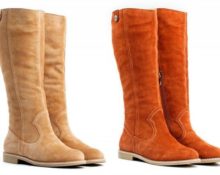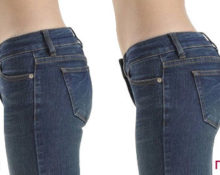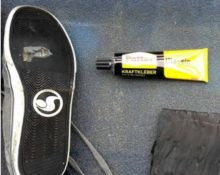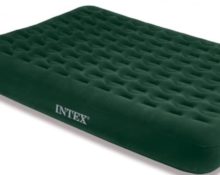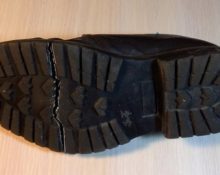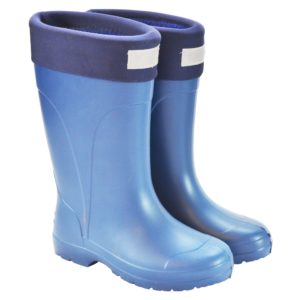 Previously, waterproof boots were used only for hiking and fishing. Now the range is much more diverse. In addition to hiking ones, there are also glamorous models for graceful legs in rainy weather. After all, they guarantee that your and your children’s feet will remain dry, and no one will catch a cold.
Previously, waterproof boots were used only for hiking and fishing. Now the range is much more diverse. In addition to hiking ones, there are also glamorous models for graceful legs in rainy weather. After all, they guarantee that your and your children’s feet will remain dry, and no one will catch a cold.
Unfortunately, stepping on a nail, etc. can damage your shoes. What to do in this case? Let's look at how to make repairs yourself at home, to the delight of your loved ones.
Pros and cons of EVA
Nowadays they enjoy deserved popularity polymer models of different shades.
EVA – ethylene vinyl acetate, whipped until foam forms.
Advantages:
- Greater ease - manufacturers of children's shoes took advantage of this circumstance.
- The polymer is elastic, pleasant to the touch, and has a memory effect, which makes them indispensable when creating orthopedic models.
- Water resistance is like rubber ones, and the weight is disproportionately less.
- The polymer is wear-resistant; damage, if it occurs, will only be due to punctures or cuts. That's when EVA glue comes in handy, but others won't work.
- Hygiene – does not contribute to the appearance and spread of fungi and bacteria.
- Hypoallergenic, which is why it is used to create knitwear and footwear for medical workers.
- Resistant to oils and solvents.
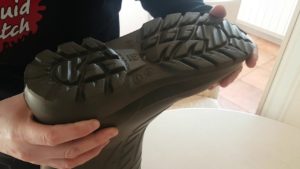 Flaws:
Flaws:
- Sensitivity to sharp objects. It is possible to cut through or pierce a thing with an ordinary push pin.
- The anti-slip properties are quite weak. This problem is solved by the release of ribbed soles used to prevent falls and injuries.
And here with EVA damage Glue can handle similar components.
Glue
Glue characteristics:
- It has a microporous structure, does not release heat even at a significant minus.
- Hypoallergenic, does not absorb moisture, and is easy to wash.
- But the biggest advantage is light weight, much less than PVC.
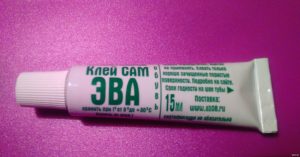 Unfortunately, excessive lightness and porous structure do not contribute to strength, and the products are easily damaged mechanically. There is glue for EVA (ethylene vinyl acetate). First, a yellowish tint appears when gluing, then disappears.
Unfortunately, excessive lightness and porous structure do not contribute to strength, and the products are easily damaged mechanically. There is glue for EVA (ethylene vinyl acetate). First, a yellowish tint appears when gluing, then disappears.
Properties:
- Does not allow moisture to pass through, is water resistant.
- Does not spread to the sides when gluing.
- The place of repair is almost impossible to see due to the transparency of the composition.
- The product lasts for a long time, thanks to which the damaged area is not afraid of leakage.
- You will use the glue slowly, as you should spread it thinly.
- The relatively low cost is a definite advantage.
- Long term of use - 24 months.
Important circumstance:
- EVA glue is not used for repairing PVC products.
- It also won’t work to glue the PVC patch onto the EVA, which is connected into a “joint”.
- It is advisable to press down on the damaged area so that the inner part rises up. We apply a thin layer of the composition right here.
Preparatory work to seal fishing (wading) boots
Surface preparation:
- Wipe the damaged area dry.
- It is advisable to first degrease it with acetone.
Step-by-step sealing of boots
Instructions:
- Squeeze the cut area so that the porous surface of the ethylene vinyl acetate comes out. This must be done, because otherwise nothing will stick together.
- Apply glue for the first time and wait about 5 minutes.
- Repeat. After 5 minutes, connect the joint, pressing it firmly.
- Apply a thin layer of glue, as excessive amounts will reduce the quality of bonding!
- The hardening process lasts 24 hours.
- The quality of the composition is high - it is impossible to tear a successfully glued product at the place of the cut.
Rules for working with EVA
Sneakers and boots made of EVA can only be repaired by a similar material - EVA glue. The glue is easily absorbed into the porous structure of the shoe. No patches are required for repairs. You just need to apply a thin layer of glue to the damaged area and press. After such repairs, the boots will look great, nothing will be noticeable.
How to glue PVC boots (step by step)
Materials:
- A couple of patches made of waterproof material that will cover the damaged area.
- Glue, maybe a moment.
- Hairdryer
- Fine-grit sandpaper.
- Acetone for degreasing.
- Gloves.
- Napkins for wiping off excess glue.
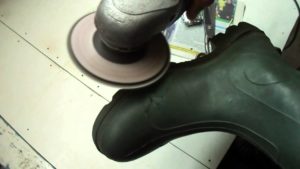 We repair PVC shoes and produce:
We repair PVC shoes and produce:
- Use sandpaper to clean the surface with the defect and the patch. The area will become a little rough.
- Degrease it with acetone. Apply glue to the desired area and patch and wait a quarter of an hour. Then we apply the next layer of glue and wait for half an hour.
- We heat the glue with a hairdryer and apply the patch, applying glue to it both outside and inside.
- Press the parts tightly against one another and hold for about 5 minutes. After proper repair, the boots will be no worse than new ones and will serve you for a long time!
Is it possible to repair the soles of rubber boots?
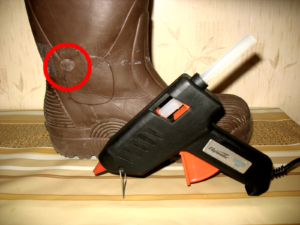
Stages of work:
- First, we will process the damaged area on a sharpening machine to achieve smoothness.
- It is preferable to use sealants.
- Applying a patch in this case will not lead to the desired result. When walking, the patch wears out, and repairs will need to be made endlessly.
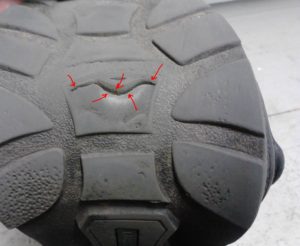 So, we are convinced that nothing is impossible. Basically, you should strictly adhere to simple rules:
So, we are convinced that nothing is impossible. Basically, you should strictly adhere to simple rules:
- cleaning with acetone;
- double application of glue;
- introducing glue inside.
Proper repair will make your comfortable shoes serve you for many more years! Happy fishing, comfortable hike and dry feet everyone!


 0
0